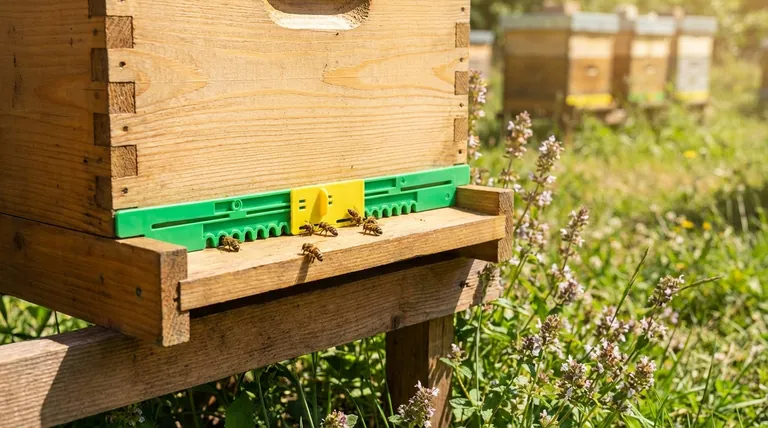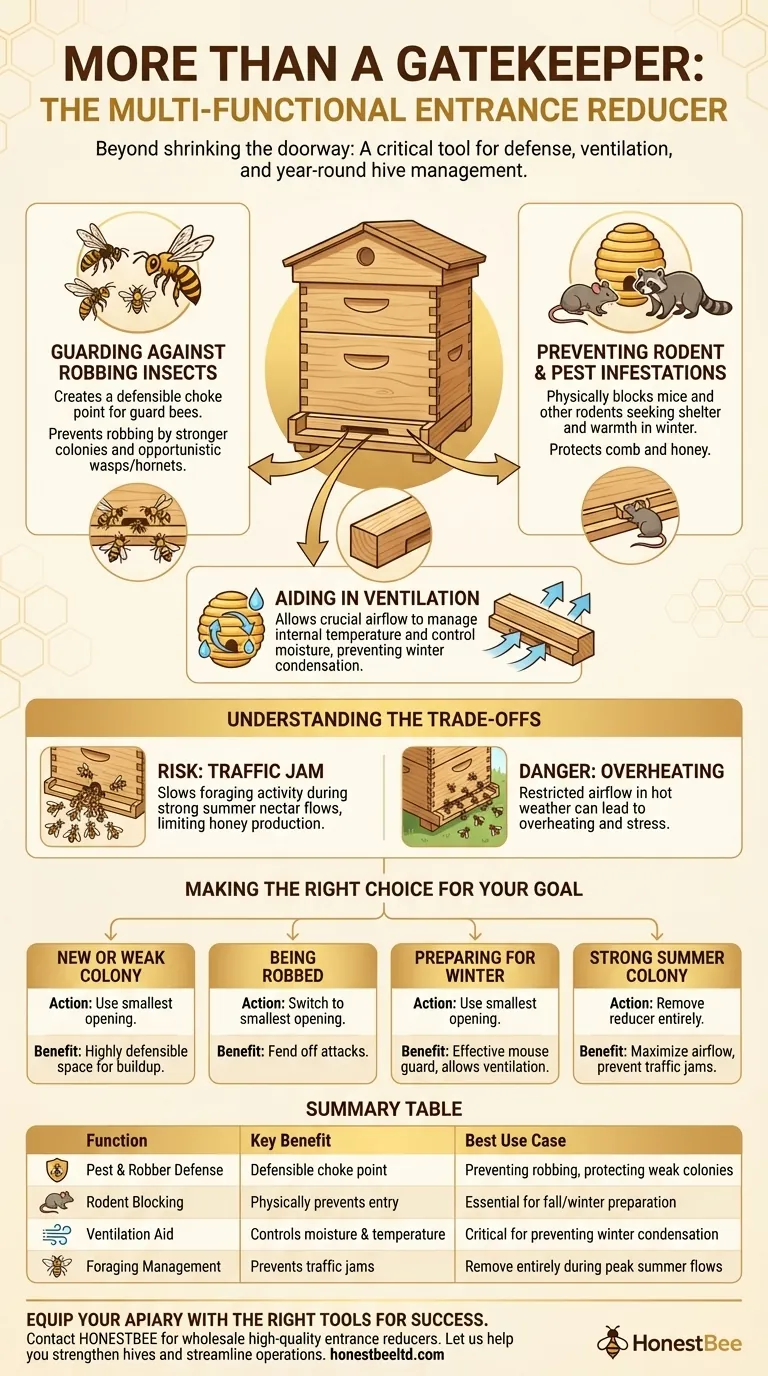An entrance reducer is far more than just a gatekeeper. While its primary job is to shrink the hive's main doorway, it also serves as a critical defense tool against pests and robbers and provides essential ventilation, making it a key piece of equipment for year-round hive management.
The core function of an entrance reducer isn't just to make the entrance smaller, but to create a defensible space. It allows a colony to scale its defenses to its population size, protecting it from threats it would otherwise be vulnerable to.

The Reducer as a Multi-Purpose Shield
A simple block of wood with different-sized notches may seem basic, but it serves several distinct and critical functions that protect the health and security of your colony.
Guarding Against Robbing Insects
A wide-open entrance can be an open invitation to intruders. A reduced entrance creates a choke point that the colony's guard bees can more easily defend.
This is especially critical for preventing robbing from stronger honey bee colonies, as well as opportunistic wasps and hornets looking for an easy meal of honey or brood.
Preventing Rodent and Pest Infestations
As temperatures drop in the fall, mice and other rodents seek warm, sheltered places to build nests for the winter. A beehive, full of insulating wax and energy-rich honey, is an ideal target.
An entrance reducer with a small opening physically blocks mice from entering the hive, where they can destroy comb, contaminate honey, and stress the colony. It can also deter larger predators like raccoons and opossums from reaching into the hive.
Aiding in Ventilation
Even when set to its smallest opening, an entrance reducer is designed to allow for adequate airflow.
This ventilation is crucial for the colony to manage internal temperature and, more importantly, control moisture levels. Proper air exchange helps prevent condensation from building up inside the hive, especially during the cold winter months.
Understanding the Trade-offs
Using an entrance reducer is a dynamic process. Leaving it on the wrong setting at the wrong time can hinder a colony's progress.
The Risk of a Traffic Jam
For a large, booming colony during a summer nectar flow, a small entrance can create a bottleneck.
This "traffic jam" slows down foraging activity, as bees struggle to get in and out. This can reduce the amount of nectar the colony can bring in, limiting honey production.
The Danger of Overheating
Bees work hard to regulate the hive's internal temperature. In hot weather, a restricted entrance makes this job much more difficult.
Insufficient ventilation can lead to overheating and cause bees to "beard" on the outside of the hive instead of working inside. For strong colonies in the summer, removing the reducer completely is often necessary.
Making the Right Choice for Your Goal
Adjusting the entrance reducer is a key part of seasonal bee management. Your decision should always be based on the colony's current strength and the time of year.
- If you are installing a new or weak colony: Use the smallest opening to give the bees a tiny, highly defensible space to protect as they build up.
- If your hive is being robbed by wasps or other bees: Immediately switch to the smallest opening to help the guard bees fend off the attack.
- If you are preparing for winter: Use the smallest opening to act as an effective mouse guard while still allowing for ventilation and cleansing flights.
- If you have a strong, populous colony in peak summer: Remove the reducer entirely to maximize airflow and prevent a foraging traffic jam.
Ultimately, viewing the entrance reducer as a flexible tool allows you to actively manage your hive's security and productivity throughout the year.
Summary Table:
| Function | Key Benefit | Best Use Case |
|---|---|---|
| Pest & Robber Defense | Creates a defensible choke point for guard bees | Preventing robbing by other insects; protecting weak/new colonies |
| Rodent Blocking | Physically prevents mice from entering the hive | Essential for fall and winter preparation |
| Ventilation Aid | Allows airflow to control moisture and temperature | Critical for preventing condensation in winter |
| Foraging Management | Prevents traffic jams for strong summer colonies | Remove entirely during peak nectar flows for maximum efficiency |
Equip your apiary with the right tools for success.
An entrance reducer is a simple but vital component for proactive hive management. At HONESTBEE, we supply commercial apiaries and beekeeping equipment distributors with durable, high-quality entrance reducers and other essential supplies through our wholesale-focused operations.
Let us help you strengthen your hives and streamline your operations. Contact our team today to discuss your wholesale needs and discover how our equipment can contribute to the health and productivity of your colonies.
Visual Guide

Related Products
- Multi-Functional Sliding Hive Entrance for Beekeeping
- Professional Hive Front Entrance Bee Feeder
- HONESTBEE Entrance Bee Feeder Professional Hive Nutrition Solution for Beekeeping
- Australian Pine Wood Langstroth Screen Bottom Board for Wholesale
- Professional Bamboo Queen Isolation Cage
People Also Ask
- How does the sliding design of the entrance reducer benefit beekeepers? Achieve Ultimate Hive Control
- What is the purpose of placing an object in front of the hive entrance after a move? A Guide to Forced Reorientation
- What additional functions do hive entrances serve? A Key to Colony Health, Security, and Productivity
- How does entrance configuration vary seasonally for beekeepers? A Guide to Year-Round Hive Health
- How can a Langstroth hive entrance be adjusted? Mimic Natural Bee Preferences for a Healthier Hive















